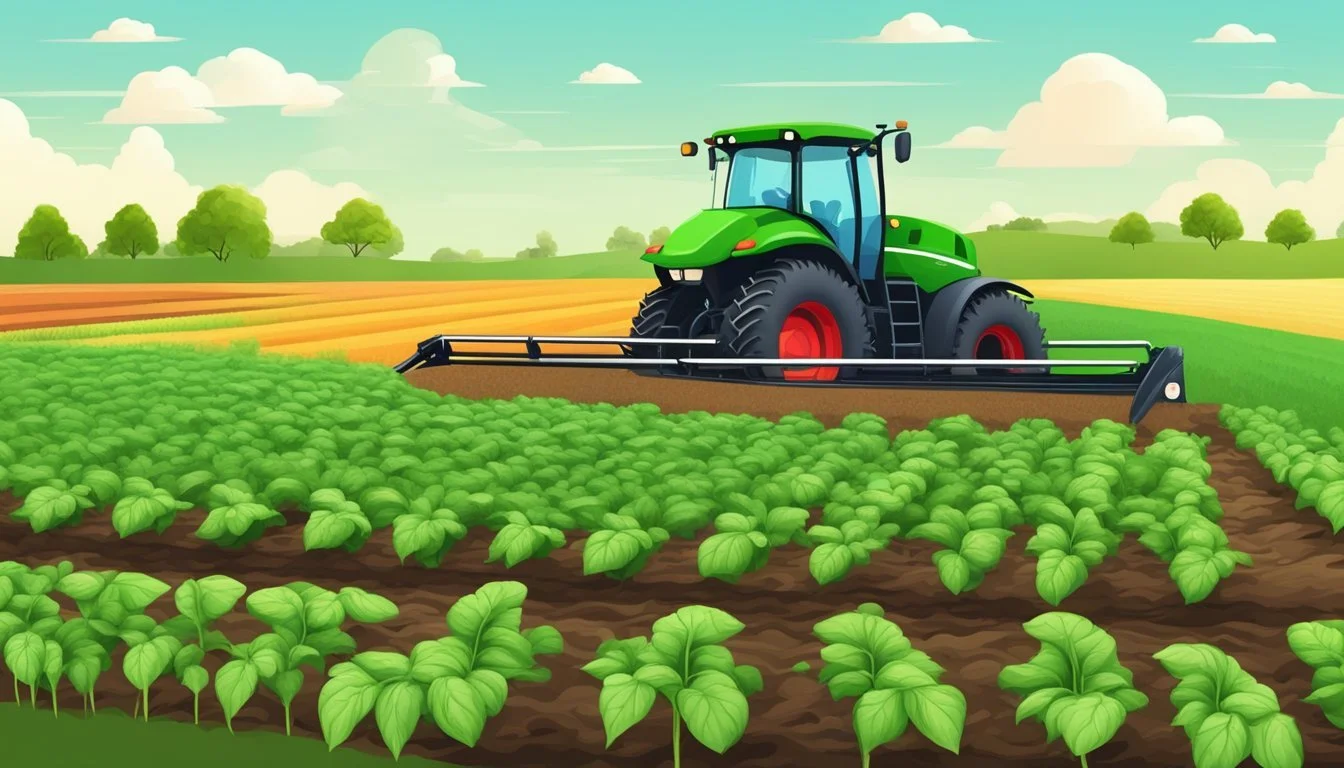Crop Rotation for Pest Control
Sustainable Strategies to Protect Your Farm
Crop rotation is an agricultural technique that involves alternating the species of crops grown in a particular field on a seasonal basis. This method of farming plays a crucial role in managing pests and diseases by disrupting the life cycle of pests that are specific to certain crops. Pests often rely on a single type of plant for sustenance and habitation; by changing the crop, their primary source of food and habitat is removed. This leads to a natural decline in the pest population, reducing the need for chemical interventions.
Incorporating this strategy is part of an integrated pest management (IPM) approach. Crop rotation does not operate in isolation but achieves optimal results when combined with other pest control methods. These methods can include using pest-resistant cultivars, biological pest control, and maintaining good sanitation in the field. Frequent crop rotation can substantially lower the risk of pests and diseases that can otherwise devastate monoculture crops, which are more vulnerable to widespread infestation and can lead to significant economic losses.
The effectiveness of crop rotation depends largely on understanding the life cycle of the target pests and the range of their host plants. For instance, if a pest has a narrow host range and is immobile for a significant part of its life, crop rotation can be exceptionally effective. This long-practiced farming technique underlines the critical intersection of ecological knowledge and agricultural practice, reinforcing how traditional methods can offer sustainable solutions to contemporary farming challenges.
Fundamentals of Crop Rotation
Crop rotation is a time-tested agricultural practice aimed at managing pest populations, improving soil health, and enhancing yield outcomes. It involves the systematic alternation of different types of crops in the same field across a sequence of growing seasons.
Defining Crop Rotation
In agriculture, crop rotation is the strategic practice of growing a series of dissimilar types of crops in the same area in sequential seasons. This management technique is beneficial because it disrupts the life cycles of pests, mitigates soil-born diseases, and can lead to better soil quality through diversified plantings.
Benefits of Crop Rotation
The rotation of crops in a given field can significantly reduce the reliance on chemical pest control methods since different crops often deter specific pests and diseases. Improved soil structure and fertility result from varied root systems and nutrient demands. Key benefits include enhanced disease management, weed management, and bolstering of soil health. It's a cornerstone of sustainable agriculture, supporting long-term agricultural productivity.
Common Crop Rotation Systems
Different rotation systems are employed based on the needs of the agriculture sector involved. A traditional rotation might involve cash crops, such as maize followed by small grains, like wheat, and then legumes, to fix nitrogen into the soil. The inclusion of cover crops in rotation schedules can further enhance soil quality by preventing erosion and adding organic matter. Each system is tailored to the specific challenges of the environment and the economic goals of the farm.
Pest Control through Crop Rotation
Effective pest management in agriculture often incorporates crop rotation, a method that strategically alternates the types of crops planted on a piece of land. Crop rotation is a pivotal practice in disrupting pest life cycles and preventing disease spread.
Mechanisms of Pest Reduction
Crop rotation works by breaking the life cycles of insect pests and pathogens that thrive on specific host plants. For instance, if a field is continuously cultivated with cabbage, pests such as the cabbage worm that specialize in feeding on brassicas can become established and problematic. By alternating with non-host crops, the population of these pests can be reduced since their preferred food sources are no longer available.
Biological control is enhanced with crop rotation because natural enemies of pests, like predatory insects and parasitoids, can thrive and maintain pest populations at lower levels due to increased biodiversity.
Crop Rotation as a Preventive Strategy
Implementing crop rotation as part of a preventive strategy for pest management offers long-term benefits. Regularly rotating with a non-host crop diminishes weed growth due to disrupted life cycles, thus lessening the likelihood of a large weed seed bank. Furthermore, crop rotation can reduce the reliance on chemical control methods, making this an environmentally friendlier option as well.
For crops such as broccoli and other brassicas, rotating with non-related crops helps keep soil-borne diseases and pests like the Mexican bean beetle from becoming entrenched.
Case Studies: Crop-Specific Examples
Brassicas (e.g., cabbage, broccoli):
Rotating with crops like legumes can reduce the impact of the cabbage worm and other brassica-specific pests.
Studies have shown less incidence of clubroot, a common disease in brassicas, when a proper rotation is followed.
Western Corn Rootworm:
This pest has historically been managed by rotating non-host crops like soybeans, but adaptation by the pest now requires more diverse rotation strategies.
Research advocates using a rotation inclusive of various crops such as oats or alfalfa can disrupt the rootworm population.
Soil Management with Crop Rotation
Crop rotation is essential in sustainable agriculture, playing a crucial role in maintaining and improving soil health. It involves the sequential planting of different types of crops in the same area across seasons to manage soil fertility and structure.
Improvement of Soil Structure
Tillage practices combined with crop rotation can significantly affect soil structure. For instance, rotating field crops that require minimal tillage with those that benefit from conventional tillage can contribute to soil conservation. The inclusion of deep-rooted crops in rotation can create channels in the soil, helping to alleviate compaction. Over time, crop rotation can lead to improved water infiltration and reduced soil erosion, especially when paired with conservation tillage.
Enhancing Soil Fertility
Crop rotation, particularly when it includes legumes, naturally enhances nutrient management. Legumes have the ability to fix atmospheric nitrogen, enriching soil with this essential nutrient for subsequent crops. Furthermore, varying crops prevent the depletion of specific nutrients, unlike monoculture where the same crop may exhaust particular soil nutrients. Regular incorporation of varied species increases organic matter in the soil, which is key to nutrient availability and overall fertility. Crop rotation also helps mitigate soil-borne diseases, minimizing the pathogen load in the soil.
Challenges and Adaptation
Effective crop rotation for pest control is not without its challenges. Both the propensity of pests to develop resistance and the influence of environmental factors must be keenly considered to maintain the vigor of crop rotation strategies.
Managing Resistance and Adaptation
Pests are dynamic and can quickly adapt to management tactics, such as crop rotation. Pest populations evolve, developing resistance to previously effective control measures, necessitating continuous observation and adaptation of crop rotation plans. Management must be proactive; for example, integrating varying lengths of rotation and diversifying crop families can help thwart pest adaptation. Adapting rotation sequences in response to population changes observed can also mitigate the onset of disease resistance.
Environmental Factors and Rotation Planning
Precise rotation planning must account for numerous environmental factors that influence crop success and pest suppression. Climate variability greatly affects pest life cycles and therefore the efficacy of crop rotation. For instance, warmer temperatures may accelerate pest reproduction, requiring more frequent rotation. Furthermore, maintaining soil quality is paramount; healthy soil supports robust crops which can better withstand pests. Effective rotation planning involves selecting crops that improve or at least maintain soil health, and adapting rotations according to environmental observations.
Integrating Crop Rotation with Other Practices
Integrating crop rotation with complementary agricultural practices can enhance disease management, improve biological control, and effectively suppress weed growth. Diversification through these integrated methods provides growers with a multi-layered defense against common agricultural challenges.
Cover Crops and Green Manures
Cover crops, such as hairy vetch, play a vital role in enhancing soil fertility and controlling weeds. When used in conjunction with crop rotation, they contribute to disease management by disrupting the life cycles of pathogens. Cover crops can also offer biological control benefits by providing habitats for beneficial insects that prey on pests. Here is an example of how growers can incorporate cover crops:
Autumn: Plant hairy vetch after harvesting the main crop.
Winter: Allow it to grow, fixing nitrogen in the soil.
Spring: Tillage incorporates the vetch into the soil before planting the next crop.
This process not only suppresses weeds but also prepares the field for the next planting season with improved soil structure and nutrient content.
Tillage and Residue Management
Proper soil tillage and plant residue management are critical when integrating crop rotation. Tillage can help to bury weed seeds and reduce weed growth, but it should be managed to prevent soil erosion. The timing and method of tillage can influence the effectiveness of crop rotation in pest and weed management. For example:
Shallow tillage: This can be employed after harvesting to incorporate plant residues, enhancing decomposition and disrupting pests and weeds.
Incorporating plant residues back into the soil can help break down disease-causing organisms and add organic matter to the soil, which is beneficial for the upcoming crops. However, growers must balance the benefits of tillage with the potential for soil disruption. Selective tillage and precise residue management in alignment with crop rotation schedules can maximize the benefits to soil health and crop productivity.
Application in Different Farming Systems
The efficacy of crop rotation for pest control varies across farming systems, each adopting unique strategies to maximize benefits. This approach balances nutrient usage and disrupts pest and disease life cycles.
Crop Rotation in Organic Systems
In organic systems, farmers prioritize natural pest control methods, often incorporating crop rotation as a central component. By alternating field crops, they create an environment less hospitable to pests and diseases that might otherwise thrive. For example, a legume crop can be followed by a non-legume to balance soil nitrogen levels, which in turn affects pest populations. This practice is crucial in organic arable crop farming, where synthetic pesticides are avoided.
Conventional Farming and Crop Rotation
Although different in their use of agrochemicals, conventional farming practices also utilize crop rotation strategies. These systems may involve a broader array of crops, including the strategic integration of double-cropping to optimize land use and manage pest populations. For instance, growers may rotate between grain crops and cover crops to improve soil health and mitigate pest issues.
Specialized Techniques for Small-scale Farming
Small-scale farming and gardening often involve more intensive observation and manual pest control methods. Vegetable gardens, due to their diverse planting, can benefit from a detailed crop rotation schedule, where each vegetable group succeeds the other in a planned sequence. Small-scale growers might also implement intercropping, where companion plants are used to naturally repel pests.
Future Prospects in Crop Rotation
Cultivating an understanding of how crop rotation will adapt and evolve is crucial for its successful implementation. Anticipating changes in this agricultural practice is paramount for growers seeking sustainable farming futures.
Innovations in Rotation Planning
Innovations in crop rotation planning are heavily based on integrating technology with traditional techniques. Data-driven tools are expected to become more prevalent, utilizing observation and adaptation strategies to optimize planting schedules. This leverages historical yield data and disease occurrence patterns, allowing growers to make informed decisions on crop sequences. Artificial intelligence (AI) and machine learning have the potential to analyze multiple factors, including soil health and climate conditions, rendering agriculture less reliant on chemical pest control methods.
Policy and Economic Considerations
The economic rationale behind crop rotation will likely be influenced by both market trends and policy incentives. Growers will consider the profitability of various crops impacted by subsidy frameworks or carbon credit programs advocating for sustainable practices. Policies may also stimulate investment in research for crop rotation adaptation, enabling farmers to refine their techniques in response to global food demands and environmental challenges. Economic considerations, alongside policies, will play a pivotal role in shaping the future patterns and success of crop rotation in agriculture.
Conclusion
Crop rotation stands as a critical component in sustainable pest management strategies. This practice involves the systematic alternation of different crops in a given field across successive seasons. It serves to disrupt pest life cycles, thereby reducing pest populations and minimizing the reliance on chemical pesticides.
Benefits to soil health are evident through this method. The diversity of crops ensures a balanced nutrient uptake and can improve the structure and organic content of soil. By preserving soil health, crop rotation enhances the resilience of crops against pests and diseases.
It is important to integrate other pest control methods with crop rotation for optimal results. These can include:
The use of pest-resistant cultivars
Biological control measures
Good farming sanitation practices
Through the lens of crop rotation, farmers can approach pest control in a manner that conveys environmental stewardship while maintaining farm productivity. It caters to long-term ecological balance and proves to be an indispensable tool in the agricultural sector's arsenal against pests.
Frequently Asked Questions
In the practice of agriculture, crop rotation is a strategic approach to managing pests. This section addresses common queries regarding its advantages, implementation, and integration with other pest control methods.
What are the advantages of using crop rotation for pest management?
Crop rotation breaks pest life cycles and mitigates the buildup of pests by alternating host plants, creating a less hospitable environment for them. This strategy can lead to a natural reduction in pest populations without the need for chemical interventions.
How does crop rotation contribute to minimizing pesticide usage?
Through crop rotation, farmers can limit pest resurgence and reduce the need for pesticides. By disrupting pest life cycles, this practice can lower pest densities, resulting in a decreased dependence on chemical pesticides.
What are some effective examples of crop rotation that control pests?
Rotating crops such as legumes with non-host crops like cereals can control soil-borne diseases and nematodes. This crop rotation method is instrumental in managing pests with specific host requirements.
How does intercropping complement crop rotation in controlling pests?
Intercropping involves growing different crops in proximity and can protect plants by creating a physical barrier or by attracting beneficial insects. When combined with crop rotation, these techniques can synergistically reduce pest populations and impact.
What constitutes an effective crop rotation schedule for pest control?
An effective crop rotation schedule requires understanding the pests' life cycle and host preferences. Rotations should be planned to prevent the return to a field of crops that are susceptible to the same pests for several years.
In what ways is crop rotation considered a type of integrated pest management (IPM) control method?
Crop rotation is a cornerstone of integrated pest management (IPM), as it employs cultural practices to manage pests in an ecologically sustainable way. It complements other IPM tactics like biological control and habitat management.




